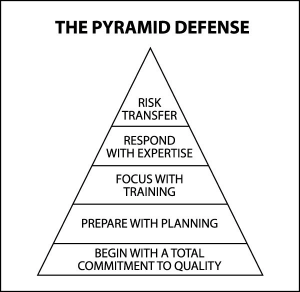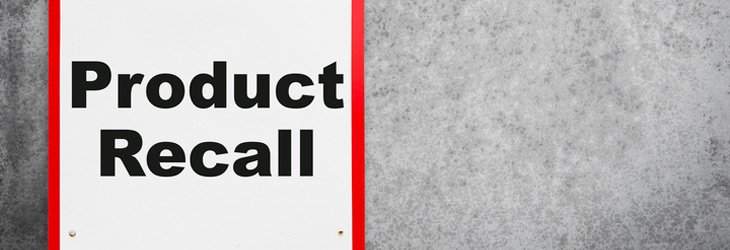Product Recall Insurance Will Help Your Business Be Ready for the Unexpected
What can a risk manager learn from today’s major recalls and the amount of media attention they attract? For consumer goods manufacturers and distributors, it serves as a wake-up call to the impact of a product recall event and a lesson in what should be done now to prepare for potential exposures.
The federal government generally mandates more than 1,000 product recalls each year. Not including voluntary recalls, which are unrecorded, that’s an average of almost four recalls a day. Costs from a product recall or contamination can easily cascade into the millions of dollars. In addition to the physical expense of a recall, reduced sales due to poor consumer confidence, brand rehabilitation expense, and potential shareholder lawsuits may also contribute to long-term losses. On top of financial losses, faulty products cause an estimated 27,000 deaths per year.
Despite recall frequency and the potential for extraordinary costs, most companies don’t adequately plan, prepare, practice for, or buy insurance against product recall events. In addition to proper insurance coverages, careful planning is essential in managing the risk of a recall.
First-Party vs. Third-Party Exposure
There are two categories of exposure to loss for a company faced with a product recall incident: first-party operational losses to the company and third-party liability losses to injured persons.
Unlike third-party losses, a first-party loss is often overlooked. In addition to the initial recall expenses, the potential long-term losses from the damage to a company’s reputation and loss of sales may continue for months or even years. Since these losses can be catastrophic, this article focuses on ways to manage first-party incident exposures.
Risk Management Considerations
It’s a common misconception that product recall is covered under a general or product liability policy. Those coverages do a good job of covering bodily injury and property damage but generally exclude contamination and recall events. The addition of a product contamination or product recall policy protects a company’s bottom line by covering the direct costs of the recall, but transferring the risk is only one part of closing the recall exposure gap.
Every company with products on the market, regardless of size, should establish solid product risk management policies and procedures for handling a recall or contamination event.
Contamination Perils for Product Recall Insurance
It’s helpful to understand the three basic contamination perils when designing a risk management program that provides the best protection for the least cost:
- Malicious tampering (intentional contamination) is prone to publicity, so it may seem common. In reality, malicious tampering is rare, but when it strikes, it tends to be a very severe loss. Managing this risk exposure can be difficult, as motives vary widely.
- Accidental contamination is an unintentional error in the manufacturing, packaging or storage of a product. This includes the mislabeling of ingredients, contamination by a foreign object or chemical and other accidents. This peril is the most common, but the majority of incidents are discovered prior to shipment. Therefore, these events receive very little publicity. As opposed to malicious tampering, this peril has very high frequency but relatively low severity. While most accidental contaminations are small events, historically the largest losses have been due to accidental contaminations.
- Product extortion is the most difficult peril to characterize. Its frequency is between that of malicious tampering and accidental contamination. Its severity, however, is more difficult to quantify. Most extortions are amateur hoaxes but may evolve into outright tampering cases, which can be very costly.
Pyramid Defense
Think of your risk management plan as a pyramid that outlines a series of defenses to counter the threat of a product incident. The first line of defense is the base of the pyramid. What actions can be taken to eliminate the majority of threats, such as unwanted bacteria, disgruntled employees, malfunctioning equipment, sloppy suppliers or lax testing? Put that in the first tier (bottom) of the pyramid.
Any threats that escape being eliminated by the first tier should be addressed by the second, and so on. As the pyramid rises, the plan becomes more specific and more effective at isolating and eliminating product incident threats.
- Tier 1 – Total commitment to quality. The good news is that most of what can be done to protect against a product incident occurs in the area of product quality assurance and control. Commitment to turning out the highest quality products day after day is the best countermeasure to the threat of a product recall crisis. This dedication to quality should be evident in every aspect of a business, from manufacturing to marketing. The logic is simple. If the product can’t leave the plant in a contaminated state and the packaging is designed so that tampering is difficult to accomplish (or obvious once done), the odds of experiencing a major incident are considerably reduced.
- Tier 2 – Prepare with a contingency plan. It’s essential to have a plan in place before a crisis arises. Every company should have a workable product recall and crisis management plan.
- Tier 3 – Focus on training. Contingency plans aren’t of much use if they haven’t been tested and honed under simulated conditions to ensure the plan works.
- Tier 4 – Respond with expertise and decisiveness. Even with a good team and a good plan, there is a place in a recall crisis for professional consultants.
- Tier 5 – Transfer risk where possible. Even the best companies who are prepared for a recall can suffer substantial financial losses. In spite of all precautions, a large-scale public recall may cost millions of dollars in extra expense, lost profits, lost inventory, lost shelf space and lost market share. If it comes to this, the last line of defense is a solid product recall insurance program—one that indemnifies the host of extra expenses and losses in revenue that comes with product withdrawals.

Transferring the Risk
Insurance for first-party losses caused by product tampering and contamination incidents are broadly labeled as product recall insurance. Product recall policies help to cover the additional costs of a recall, including product loss, costs to withdraw the product from the market, product disposal, product testing, overtime wages and crisis management—costs that can be devastating because they arise at a time when a company’s revenues are typically hardest hit.
There are several coverage forms, each designed to isolate some component of first-party product exposure. Work with your Insurance Advisor to ensure your product recall policy provides indemnity for the following:
- Recall expense. This out-of-pocket expense is associated with executing a large-scale product withdrawal. It includes costs like extra temporary employees, overtime, public safety messages, special testing and handling, destruction and disposal costs and crisis management and/or PR consulting fees.
- Replacement cost. As the name implies, this is the cost of replacing any product that had to be destroyed. This includes the cost of materials, labor, and overhead directly associated with producing the product.
- Lost profits. This indemnifies the insured for profits which would have been earned on the withdrawn products and also for profits which would have been earned on future product sales, but which were not earned because of resultant future sales declines. This is usually limited to a specified time period.
- Brand rehabilitation expense. Most insurance companies can also indemnify the insured for necessary rehabilitation of the recalled product’s consumer image. This includes costs like extra advertising, extra expense to rush a new product to market and special promotions to rebuild public trust in the manufacturer and its products.
In addition to transferring risk, thorough risk management practices are essential to minimize the exposure and the cost of a recall event. The product recall insurance marketplace is highly specialized. Your Insurance Advisor can help secure the coverage you need and collaborate with you to develop a business contingency plan that meets your specific needs. Contact one of our Licensed Advisors today to discuss your recall plan and coverages.
